 Italy (1916-43) – About 60 ships
Italy (1916-43) – About 60 shipsOverview:
WW2 Italian Destroyers were still called cacciatorpediniere, “torpedo boat hunters”, the equivalent of French contre-torpilleur or general torpedo-boat destroyer, later simpified as “destroyer”. Part of these were dating back from WW1, and were reclassified as torpedo-boats due to their range, tonnage and armement, while others, 1918 to 1921 destroyer leaders were almost light cruisers. In the interwar, destroyer design progressed steadily. The Sella/Sauro were derived from the large 1917-18 Curtatone/Palestro class, but soon, some of the characteristics that distinguished these ships to their most obvious opponents after the Washington treaty, the French, were fixed.
Typical 1936 Transalpine destroyers were about the same tonnage but a bit smaller, with their armement concentrated in twin turret, whereas the French had them spread between decks and raised platforms, compact, relatively low superstructures, and single funnels. These standard destroyers had the same torpedo armament, similar speed (lower for leaders), and comparable -yet smaller- range.
Type-wise however, the French had a clear advantage with their numerous, large destroyers leaders. Equivalent Italian classes were rather old (Leone/Mirabello/Aquila), while the 1930s Esploratori, or “Navigatori” class, just had one more twin turret and, lower tonnage, speed and capabilities in comparison. The Italian showever had an ace of their sleeve: Their numerous, modern and capable torpedo boats, whereas the French had only a few (see in the end).
Genesis: Early Italian destroyer development
In the 1880-90s already, Italy produced a serie of “torpedo cruisers” that were in a sense, precursors of destroyers. These ships existed in four classes, Tripoli (1), Goito (2), Partenope (8) and Agordat (2) ranging from 833 to 1290 tons. Eight participated in WW1, the rest being discarded before. But like other navies the Regia Marina ventured into torpedo boats early on, also puchasing Thornycroft, Yarrow and Schichau models in the 1880-90s.
By 1898, the first proper destroyer, Fulmine, was built, followed by the Lampo (1899, 6) and Nembo (1901, 6) classes, all active in WW1. These ships were reclassified as torpedo boats from 1921 but has been discarded well before the second world war.
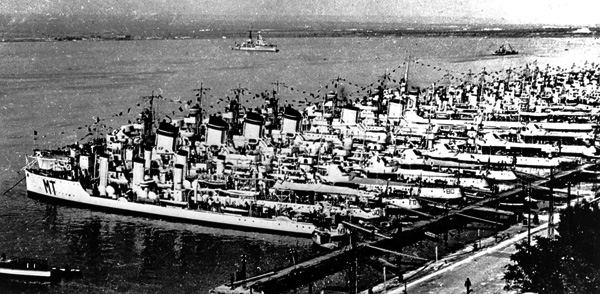
Italian destroyers at anchor in 1940
To the Soldati (1907, 9), succeeded the Indomito class (1912, 6), Ardito and Audace (1912-13, 4), Pilo (1915, 8), Sirtori (1916, 4), La Masa (1917-19, 8), postwar classes like the Generali (1921, 7). All were nimble, barely 800 tons in battle order, fully loaded. The exception were the 1919 Palestro class (4 ships), improved Audace design which had a larger displacement at 1076 tons, had two funnels, and a better AA armament. They formed the basis for interwar designs. In addition, the Regia Marina operated in the interwar a serie of foreign designs: Ascaro (ex-chinese Ching po), Audace ii (ex. Kawakaze), Ardimentoso (ex. German S49) and seven destroyers of the Austro-Hungarian Tatra type, the best they ever launched.
Flotilla leaders
Aside these, Italy also built in wartime impressive destroyer leaders: The three Alessandro poerio type (1216 tons, 1914), the three Mirabello class (1972 tons, 1915), the four Aquila (1733 tons, 1917-19), and the most impressive of them all, the postwar Leone class (2289 tons, 3 ships 1923-24). Italy also operated the war reparation ships, the ex-V116 called Premuda and ex G97 called Cesare Rossarol. Both were the largest and best German design, and were discarded in 1939. The Aquila were sold to Romania and Spain, the others participated actively in WW2.
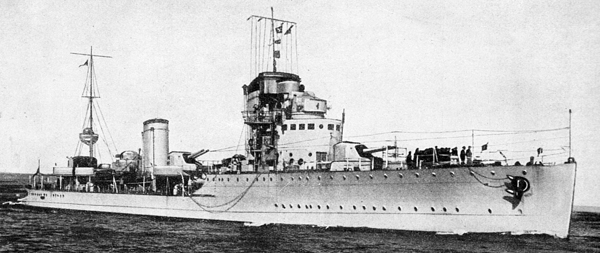
Luca Tarigo, Navigatori class prewar, showing its straight prow, later rebuilt as a clipper one. This ship single-handily duelled against four allied destroyers in the difficult escort route between Italy and North Africa.
Evolution and provision before WW2
Until the 1912 Indomito class, the previous designs were glorified high seas TBs, with a low, continuous hull with a front tumblehome, three stackers of 400 tons with ligh 3in guns and three TTs. The Indomito class, which fixed the look of Italian destroyers prior WW1 and up to 1919 inaugurated a raised forecastle, heavier 4.7 in (120 mm) guns (in addition to the 3in/40), turbines and better boilers for a much faster speed of 35 knots (vs 28 with VTE engines on previous generations). However range did not changed that much at 1200 nautical miles at moderate cruise speed. Pilo class, Audace II, Sirtori, La Masa, Palestro, and Generali classes all participated in WW2. At the start of WW2, Italy had 56 destroyers, only 7 would be built before 1943.
Interwar Italian destroyer development
As seen above, Italy ventured, like the French Navy and with the same tonnage limitations from the Washington treaty, both on large flotilla leaders and more nimble, 1000 tonnes regular destroyers. Comparisons being inevitable at this point, French and Italian designs diverged a lot however. From 1930 (Freccia class), Italian designs were strikingly different, being lighter, shorter, with a raked single funnel, twin turrets, simplified superstructure, whereas French designs were more conservative, if not retrograde in comparison, like Royal Navy models, with single shielded guns in superfiring positions, tall superstructures and three stacks. If design only was a consideration, the Italians would win this match, with better looking, more modern ships.

Scirocco of the Maestrale class
There was an evolution to this design though. The Palestro-derived designs Sella & Sauro classes (8, 1925) and Turbine class (8, 1927) combined shielded twin mounted for 4.7in (120 mm) guns, and went from two twin TT banks to to triple ones. The standard AA artillery comprised Bofors-like 40 mm/39 guns, and pairs of 13.2 mm Breda heavy machine guns. Power went from 36,000 to 40,000 hp, speed maintained to 36 knots. The Navigatori class (12 ships, 1928-29) was meteoritic.
With almost double the displacement, and a better armament with an extra 120 mm pair in the center, and better distributed rearranged TT banks, they were even faster at 38 knots. They were specifically tailored to deal with the French destroyer leaders (Jaguar/Guepard class). The Freccia class (1930, 4 ships) signalled a new, more modern design to replace the 1920s Palestro generation. Armament stayed the same, but layout differed and the powerplant was modernized and overhaul to produce and amazing 44,000 hp on a 2100 tons ships fully loaded, with the result of a top speed of 38 knots. The following Folgore, Maestrale and Oriani classes were all closely derived, whereas the prewar (and wartime) emeregency class named “Soldati” (like the ones launched before WW1) closed the design.
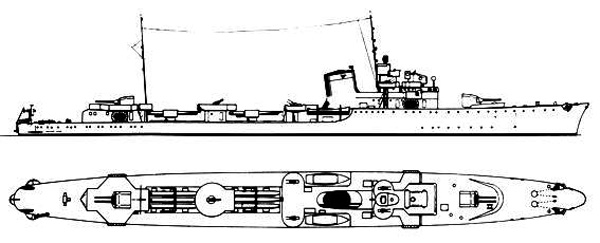
Alpino of the Maestrale Class
Wartime Italian Destroyers
The Soldati comprised 12 ships in the first group, launched 1937-1939 and a second wartime group called Bombardiere, 7 ships launched (with the exception of Carrista) in 1941-42. This was the only wartime Italian destroyer class, which is pale in comparison of the figures showed by the Royal Navy or US Navy, but approached German figures.
The last wartime design studied by Italy, of which 9 were laid down and none completed, was the Commandante Medaglie d’Oro.
These interesting designs would have incorporated more powerful 135mm/45 main twin guns and the most powerful AAA to date, on a 2900 tons design fully loaded. The two fire directors had more modern aerials and a gufo radar, also a first for Italian destroyers. Unfortunately, when the armistice came up, none were completed. They were all seized by the Germans, but no progress was made and they ended broken up on slipways after the war.

Destroyer Bersagliere in 1942 (Soldati class), showing the “wavy dark grey pattern” alternative to the standard Mediterranean angular type camouflage.
Italian Destroyers in action
In operations Italian DDs fought actively in many sub-theaters of operations and in many battles related to the “siege of Malta”, and convoy wars so severe one another links to North Africa where the bulk of the Italian Army and the Africa Korps targeted Egypt. The fact is, with the fall of France, no Italian Destroyer had ever to fight its French opponents. The only significant naval engagement between the two was the former Curtatone-class Catalafimi pitted against French cruisers and destroyer leaders in front of Genoa and Vado. Italian DDs fought British ships until the fall of 1943.

Destroyer Oriani
Italian destroyers were usually organised into Squadriglie (Destroyer Squadrons) of four ships, same class. From 10 June 1940 onwards the Regia Marina counted on sixteen Squadriglie Cacciatorpediniere or divisions. Destroyer Divisions 1 and 2 (Turbine-class), Division 3 (Red Sea, Sauro-class), Division 4 (Sella-class), Division 5 (Red Sea, Leone-class) Division 6 (Mirabello-class) Divisions 7, 8, 9, 10 (Freccia, Folgore, Oriani, Maestrale), Divisions 11, 12, 13 (Soldati-class), Divisions 14, 15, 16 (Navigatori-class).
Modern ones served as fleet escort and took active part in the many small and large engagements of the war, while older models were used as escorts on less contested areas, around Albania, Greece, the Italian Dodecanese and Aegean Sea. As escort vessels they performed anti-ships, AA and ASW defensinve action, many being re-equiped with more adequate AAA during the war, sacrificing torpedo tubes banks in the process.
They also took over mine-laying and supply transport missions. The bulk of the actions occured with the more modern ships attached to the vital route between Italy and North Africa. At the time of the Tunisian campaign when allied domination became prevalent (The Battle of Skerki Bank show the loss of 1,500 soldiers in one night) and confidence in trying to defend troop transports led to transport troops directly on destroyers instead.
Indeed a single destroyer division of 4 ships was able to carry some 1,200 troops and equipment in one night. In fact the majority of the 77,741 troops landed in Tunisia between November 1942 and May 1943, 52,000 were carried by destroyers with about 700 losses only. Italian destroyers carried out 535 escort missions, 301 transport missions and 132 minelaying missions (4,093 mines in all) and paid a heavy price in these contested waters, with forty-tree were sunk (on 59) until September 1943 and 15 after the Armistice of Cassibile, mostly scuttled.
In fact only five survived the war, showing their level of engagement. Of all the losses, ten were sunk by surface warships, and 42 by other causes, showing that classic naval surface engagement was already a thing of the past. Some of these ships fought against amazing odds, like Luca Tarigo of the Navigatori class, duelling against four DDs at once.
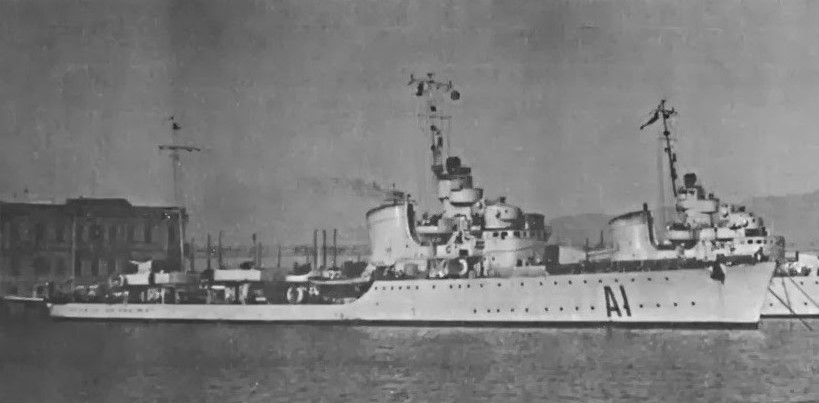
Destroyer Ascari (1st Soldati group), showing the standard light grey livery
It should be noted that many Italian DDs ended in German hands, as the Kriegsmarine desperately needed them for local operations. Also Regia Marina operated captured ships: They were captured from either France or Yugoslavia: The Premuda was the former Yugoslav destroyer Dubrovnik, captured in April 1941, a very capable unit, one of the most impressive destroyers ever built, two Beograd class former Yugoslav destroyers captured in April 1941 and French DDs that were scuttled at Toulon and later salvaged and repaired (the immense majority simply could not): FR 22 – former French destroyer of the Chacal class, and two of the Guépard class, FR 21 and FR 24, and FR 31 – former French destroyer of the Bourrasque class.
This story of transalpine DDs pretty much ends after November 1943 since the puppet-state called the RSI did not had a proper navy, limited to a handful of retroceded ships by the Germans. Indeed all surviving DDs that were not the interned in Malta following the armistice had been captured by the Germans and often integrated into the Kriegsmarine which badly needed ships in this theater of Operations. The Marina Nazionale Repubblicana or MNR was limited to nine motor torpedo boats about 12 MTSM and MTM explosive motorboats and fifteen CB-class midget submarines and the sole C1.
WW1 era Italian Destroyers
Indomito class (1913)
These 1913, 760 tons ships were all reclassified as TBs from 1929. They were all discarded in 1931-37 but Insidioso, although discarded in 1938 was not broken up, and was brough back in service after the war erupted. In 1941 she lost a funnel, and was taken in hands and refitted with a single 102mm/45 gun, and a modern AA comprising four single 20mm and two twin 13.2 mm HMG mounts. She was used for many duties, starting as a target for submarines in Pola, then an Adriatic escort vessel. Captured in 1943 she was renamed TA21, she was rearmed in German standard (Flakvierling mounts, 2×4 plus a single mount, 2x 102 mm). She was damaged by a British plane in August 1944, was repaired and then served until 5.11.1944 when she was sunk by an American aerial torpedo.
Audace (1916)
Audace, the first of this name was sunk in 1916. The second was transferred from the Japanese, then under construction at Yarrow yards in Great Britain. This vessel was reassigned to the fleet in 1940 after serving as a radio control vessel. She lost her torpedo tubes and won 20 single 20 mm AA guns. Inactive in 1943 in Venice, she was captured by the Germans and was sunk in action in November 1944 under as TA 20 near Zara, by two British destroyers, HMS Wheatland and Avon Vale.

Rosolino Pilo during the war (hence the “RP” on its hull).
Pilo class (1916)
These 885 tons ships were all in service, although reclassified as torpedo-boats. Nievo was the exception, being discarded in 1938. they were rearmed with two 102mm guns, six 20mm AA guns, four AA heavy machine guns, and keeping half of their torpedo tubes. They served as escorts. The Nullo was sunk in 1940, the Schiaffino in 1941 and the Bronzetti in 1945.
Sirtori/La Masa classes (1917-19)
The destroyers of the Sirtori classes (4 ships, 1917), and La Masa (8 ships, 1917-18-19), were assigned to the same tasks. Very close to the Pilo, they received between 6 and 8 guns of 20 mm AA during the war. The Acerbi was sunk in 1941 by an RAF plane, the others for the most part by German or allie planes when they were captured and used by the latter.
Generali class (1921)
The destroyers of the Generali class (6 units, 1921), very close to La Masa, received two 20 mm guns and some additional Breda 13.2 mm twin machine guns. They were all sunk in combat, except the Cascino and Montanari, scuttled in 1943 and 1944.
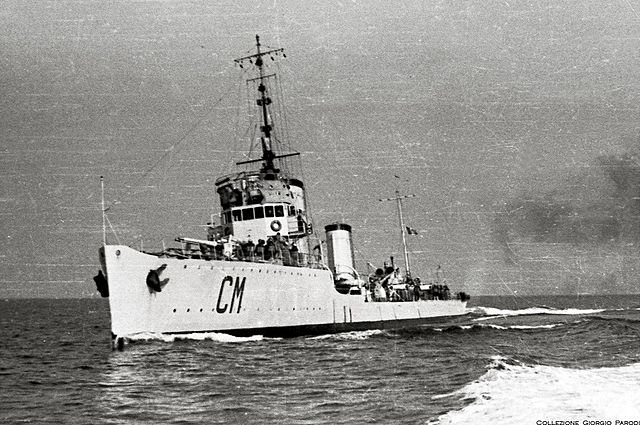
Italian TB Calatafimi, which boldly attacked French Cruisers during operation Vado
Curtatone/Palestro class (1919-21)
The first destroyers to be built in Italy after the end of World War I, their design started at the end of the war, but was modified to incorporate some war lessons. They ended as the first ships to use twin rather than single mountings. They were originally ordered in parallel to the Palestro class destroyers, but delayed and suspended due to steel shortages. The design was modified to incorporate war experience and their hulled was lengthened by 4.5 m. The ships were modernized as escort vessels during the war with single mounts, and the triple 450 mm torpedo tubes replaced by twin 533 mm ones, plus additional Breda 13mm heavy MGs while the old 76 mm/40 AA guns were removed.
The class comprised the Calatafimi (1923), Castelfidardo (1922), Curtatone (1922) and Monzambano (1923). In action, Calatafimi fought French ships during operation Vado, but was Captured by the Germans at Pireus in September 1943 (TA19) and was sunk by Greek submarine Pipinos in August 1944 in the Aegean Sea.
Castelfidardo was Captured by the at Pireus in September 1943 by the Germans and was also renamed TA16, sunk by allied aircraft in June 1944 (also in the Aegean). Curtatone was sunk by a mine near Athens on 20 May 1941, but Monzambano survived the war and was BU in 1951.

Camouflaged Monzanbano during the war – kit box art from http://stormomagazine.com
The Palestro were started first, in 1917, but were only completed after the war because of labor and materials shortages, at the Orlando shipyard in Livorno. Like the Curtatone, in 1938, they became torpedo boats. The Palestro was sunk by the British submarine HMS Osiris off Durrës, Albania, on 22 September 1940, the Confienza (CF) sank after a collision with auxiliary cruiser Capitano A. Cecchi off Brindisi in November 1940, San Martino was captured by the Germans and became TA18 in 1943, and later TA17 in 1944, mined on 18 June 1944, bombed and sunk while on repairs on September 1944 and scuttled at Salamis in October 1944. Solferino was captured at Souda (Crete) in September 1943 and became TA18 in 1944. She duelled with destroyers HMS Termagant and Tuscan off Skiathos (Aegean), ran aground near Volos and was scuttled.
Poerio Class leaders (1914)
These twin-funneled ships of 1914, displacing 1012 tons, Gugliemo Pepe and Alessandro Poerio survived WW1 and were employed for most of the interwar, but by 1938 both were ceded by Mussolini to the Spanish Nationalist, joining the Armada against the Republicans. They were renamed Teruel and Huesca and survived both the civil war and WW2, to be deactivated in the 1950s.
Aquila Class leaders (1916)
The two ships of 1916 were designed as flotilla leaders. They were well-armed, fast, three-funelled 1700 tons ships. Aquila (a reference to the Roman Eagle) was launched in July 1916 and fought during WW1 whereas Falco (another bird of prey adulated by the ancient Romans) was delayed and launched after the war in August 1919. Both served for most of the interwar before being transferred to the Spanish Nationalist Fleet (Armada) in 1939, being renamed, respectively, Melilla and Ceuta. Both also had a long career during and after the war.
Mirabello Class leaders (1916-23)
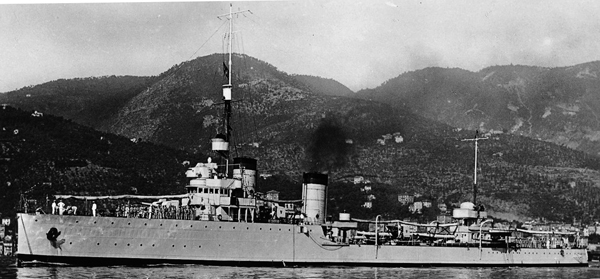
Pantera of the Leone class
These powerful ships were actually considered as scout cruisers before their construction. Both Mirabello in 1916, and the three Leone class of 1923 were pretty close in terms of their general conception, the Leone being larger and heavier. The Mirabello, of 2000 tons, participated in both conflicts, and the Leone class, rated for 2300 tons, only WW2. They acted in the fleet as “scouts”, but were redesignated destroyers in 1938. They had massive firepower. Both classes had eight 102 mm guns and two 40 mm (2-pdr) AA guns originally.
In 1938, they were given additional 13.2 mm Breda (.5 cal) heavy machine guns and in 1943, Augusto Riboty (Mirabello class) received additional 20 mm guns instead of four 102 mm guns. The Riboty survived the conflict and although offered to Russia in war damage, was refused and broken up in Italy in 1951. The Mirabello was sunk by a mine in 1941. The three Leone (also Pantera, Tigre) received a few 13.2 mm heavy machine gun twin mounts and were used actively during the conflict. They had been designed to support the Mirabello in 1917, but their construction was long delayed due to lack of resources, and they were all three scuttled in March 1941.

Author’s Profile of the Leone class
Specifications
Displacement: 2 200 t. Standard -2 600 t. Fully Loadded
Dimensions: 112 m x 10 m x 2 m
Powerplant: 2 Parsons turbines, 8 Yarrow boilers, 50 000 hp.
Top speed: 32 knots
Armament: 8 x 102mm, 2 x 40mm, 8 x 13.2mm AA, 6 x 533 mm (2×3) TTs
Crew: 210
Italian Interwar Destroyers
The evolution is three-fold. First, a classic design in the 1920s derived from the 1921 Palestro class. Then an attempt to design “exploratori”, destroyer leaders used as scouts, and third, the definition of a brand new design in 1930 and homogeneous series right up to 1942 and the new Medaglie d’Oro class.
Sella/Sauro class (1924-26)
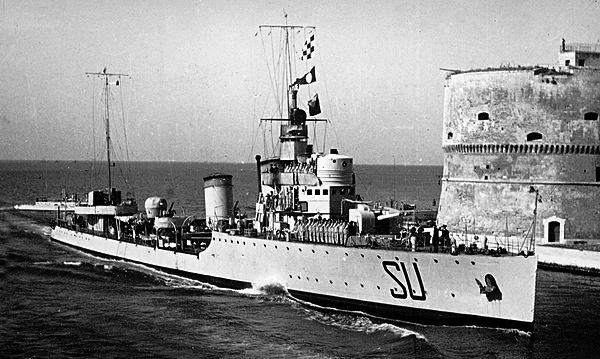
Destroyer Nazario Sauro
The Sella class (Crispi, Sella, Ricasoli, Nicotera), and Sauro class (Battsiti, Manin, Nullo, Sauro) were started in 1925-26, according to two substantially different designs. Although inspired by the Palestro and Curtatone of 1919-23, they were enlarged and reinforced to swap to an armament of 120 mm guns instead of 102 mm, and “standard” 533 mm torpedo tubes instead of the old 457 mm. The four Sella were 85 meters long, 5.60 wide with 2.70 of draft, and 955 tons standard, 1457 fully loaded (To compare with the Sauro specs below).
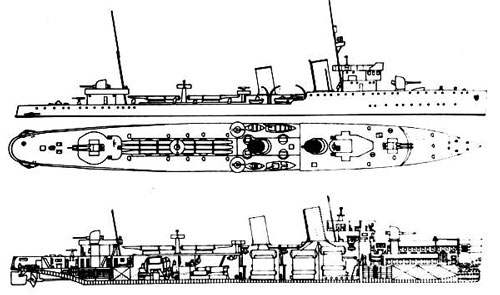
Destroyer Nullo – blueprint
On the other hand, the Sauro shared the same engine, a set of Parsons turbines fed by three Thornycroft boilers, for a top speed significantly higher than 35 knots. Their armament was identical except for the 120 mm guns. The Sella had only one double turret and one single turret, but this was rectified in 1929. The Sauro were characterized by their lower second funnels, and an enlarged bridge superstructure.
The new arrangement comprised twin turrets for and aft, very unusual to foreign standards, and later standardized to all Italian destroyers. Apart from the Bettino Ricasoli and Giovanni Nicotera, sold to the Swedes, they were all sunk during the war, the Sella by German S-Bootes after the armistice declaration with the Allies. The Sella were based at the island of Leros, in the Dodecanese.
The Sella took part in the Italian retaking of Kastelorizo (Operation Abstention) on 27 February 1941, and later as as mother ships for the explosive motor boats (MAT) on HMS York on the night of 25 March. Crispi covered the landing of an entire Italian division on Sitia, Crete, on 28 May 1941.

Author’s illustration of the Sella
Specifications
Displacement 1,040 t. standard -1 575 t. Full Load
Dimensions 90 m long, 9.2 m wide, 2.9 m draft
Machines 2 propellers, 2 Parsons turbines, 3 Thonrycroft boilers, 36,000 hp.
Maximum speed 35 knots
Armament 4 x 120mm (2 × 2), 2 x 40mm, 2 x 13.2mm AA, 6 x 533 mm (2 × 3) TTs
Crew 155
Turbine class destroyers (1928)
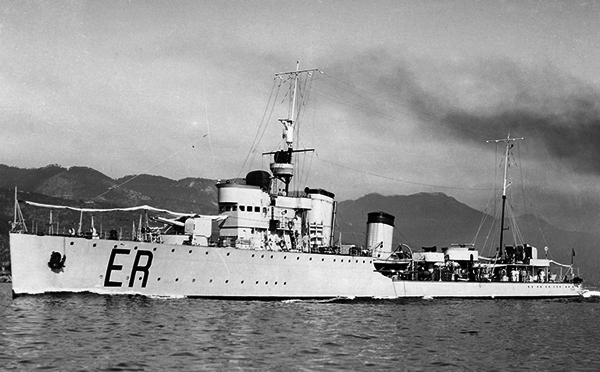
Destroyer Euro
The Turbine class (8 ships) was still very close to the previous Sauro/Sella, except for a larger size and displacement due to more powerful machinery, 2 propeller shafts connected to Parsons steam turbines, powered by three Thornycroft boilers for a total of 40,000 hp and a top speed of 36 knots. They carried 270 tons of fuel oil. Eight ships were launched this time, in Odero, Ansaldo, and CT Riva trigoso. These were the Turbine, Aquilone, Borea, Espero, Euro, Nembo, Ostro, and Zeffiro. They performed well in tests, the Turbine managing to produce more than 51,000 hp in forced heat, reaching 39.5 knots. In practice by rough seas, 33 knots were more common.
And these figures suffered in wartime after heavy use. During the war, old AA artillery was sacrificed and four 20mm Breda twin mounts were added, and two ASW grenade launchers. Turbine sacrificed her rear torpedo tube bank for two 37mm/54 AA guns. Losses: Nembo, Ostro and Zeffiro torpedoed by British planes, Borea and Euro, by British and German bombs. The Turbine served the longest. Captured by the Germans in September 1943 she became the TA14 in service for the kriegsmarine and would be sunk in September 1944 by an American plane at Salamis.
Specifications
Displacement: 1,070 t. standard -1 670 t. Full Load
Dimensions: 92.20 m long, 9.2 m wide, 3 m draft
Propulsion: 2 shafts, 2 Parsons turbines, 3 Thornycroft boilers, 40,000 hp.
Top speed: 36 knots
Armament: 4 guns of 120 (2 × 2), 2 guns of 40, 2 of 13.2 AA, 6 TLT 533 mm (2 × 3)
Crew: 179
“Navigatori” class (1928-32)
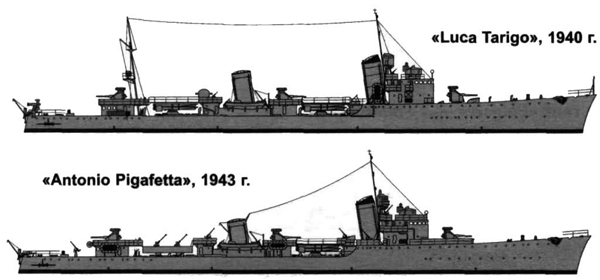
Navigatori class general appearance
These large fleet destroyers were designed and built for one purpose: To counter the heavy French destroyers of the Jaguar-type class leaders. They were doing well on the armament plan while being smaller. 12 ships were planned in total. Their tonnage was almost double of that of the Turbine class. They were also slightly faster. Their design also called some elements from the scouts of 1917 such as Mirabello and Leone. They were, however, like the latter, classified as destroyers in 1938.
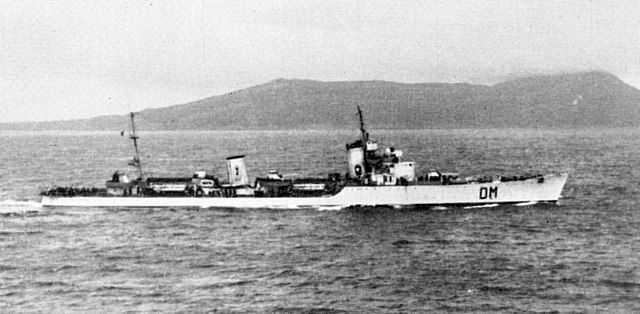
Alvise Da Mosto 1940
Their power unit was new, alternating between two boilers and a turbine, a modern and almost oversized system. As a result at official trials, they happily reached 42 knots, even 45, which in 1930 was still rare for this type of ship. However, years of service degraded these splendid performances, and in 1941, their top speed rarely exceeded 32 knots, quite a compehensive loss. These “esploratori” also suffered from excessive rolling, solved by lowering their gangway and funnels, and placing 50 cm ballasts on each side of the hull.
They were also sensitive to the blades from the front and their bow was modified, in the “clipper” style, passing the hull from 107 to 109 meters. Gradually their AA armament was modified, and they first received two twin AA 13.2 mm Breda heavy machine gun stands AA in 1934, and seven to nine 20mm Breda guns from 1940 to 1942.
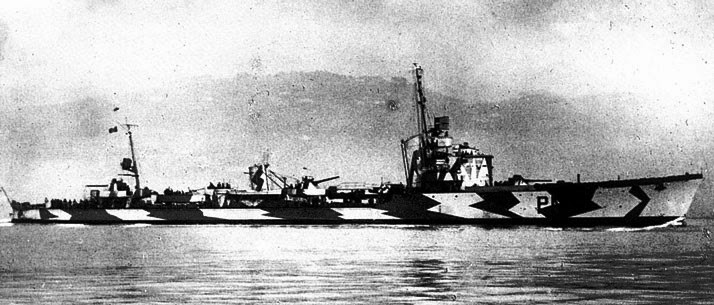
Leone Pancaldo in 1943
Apart from Nicolo Zeno, scuttled in 1943, all these ships were sunk in operations. In a heroic fight against four English destroyers, Luca Tarigo (LT) managed to sink HMS Mohawk before disappearing under the waves herself. Vivaldi was sunk in November 1943, when preparing to cross Gibraltar, by German coastal batteries. Three others were sunk by submersibles, the Antoniotto Usodimare being torpedoed by mistake by Italian submarine Alagi. Alvise Da Mosto sank in front of Tripoli on 1 December 1941, after duelling with cruisers HMS Aurora and Penelope. Da Recco was the only one of this class to survive the conflict, and was disarmed in 1954.

Illustration of the Navigatori class by the author.
Specifications
Displacement 1,900 t. standard -2,580 t. Full Load
Dimensions 109.30 m long, 11 m wide, 3.40 m draft
Machines 2 propellers, 2 Parsons turbines, 8 Tosi boilers, 50,000 hp.
Maximum speed 38 knots
Armament 6 guns of 120 (3 × 2), 2 guns of 40, 8 of 13.2 AA (4 × 4), 6 TLT 533 mm (2 × 3)
Crew 224
Freccia/Folgore class (1933)
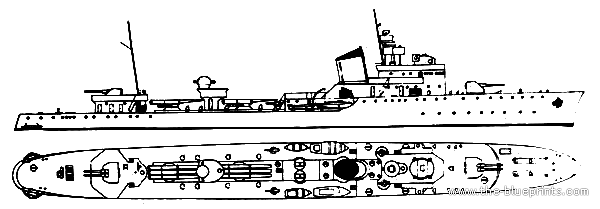
Blueprint of the Folgore class, in 1942
In line with the Turbine, the four destroyers of the Freccia class, launched in 1930-32 and completed in 1931-33, Dardo, Freccia, Saetta, and Strale, were faster to be able to intervene with the last Italian cruisers, capable of 40 knots. However in operation, this speed was rarely reached. In addition, these ships suffered from a lack of stability so grave that they had ballasts added to about 90 tons, curtailing their speed to 30-31 knots. They were thus employed for escort duties. In 1939-40, their 13.2 mm Breda machine gun mounts were replaced by five 20mm cannons, and two Deep-charges. In 1942-43, they gave up their rear torpedo tube bank for an additional battery for two 37mm cannons and three 20mm double mounts. All were lost during the conflict, including two scuttled by the Germans.
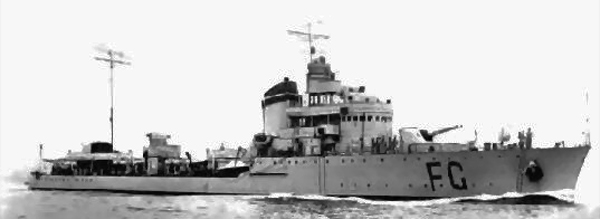
Folgore in 1931
The 4 Folgore (Baleno, Fumine, Lampo, Folgore), launched in 1931 and completed the following year, were virtually identical to the Freccia, except that their width was further reduced to reach a greater speed, to the detriment of autonomy (less space for oil tanks), while even aggravating the defects of Freccia and instability. As a result, the same modifications were applied. Their AA armament was reinforced in 1940, but only for the Lampo and Folgore. All four were sunk in engagements against British destroyers, including the famous battle of 16/4/1941.

Folgore in 1942 – Coll. Giorgio Parodi
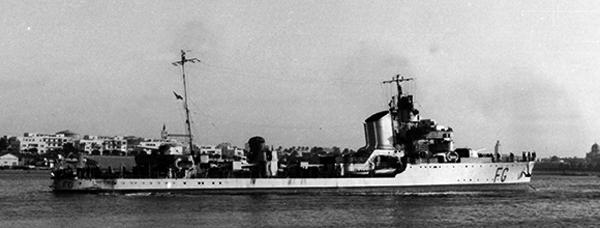
Folgore, rear view – Associazione Venus

Author’s illustration of the Saetta, Freccia class.
Specifications
Displacement: 1,205 t. standard -2 116 t. Full Load
Dimensions: 96.15 m long, 9.75 m wide, 3.15 m draft
Machines: 2 propellers, 2 Parsons turbines, 3 Yhornycroft boilers, 44,000 hp.
Top speed: 38 knots
Armament: 4 x 120 (2×2), 2 x 40, 4 x 13.2 mm AA, 6 x 533 mm (2×3) TTs
Crew: 692
Maestrale/Oriani class (1936)
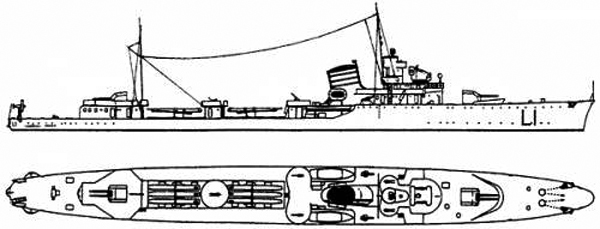
Blueprint of the Libeccio in 1940
These four destroyers of the Maestrale class (Maestrale, Libeccio, Grecal, Scirocco), and four of the Oriani class (Alfieri, Carducci, Gioberti, Oriani), were derived from the Maestrale, but of larger dimensions, particularly in the width, and a particular care accorded to the transverse masses distributions. They no longer had the excessive roll problems of the previous ones, and this allowed to re-equip them with heavier machines, more efficient in the end. Their top speed was indeed close to 42 knots on forced heat trials.

Maestrale in 1941
In 1941, they received between 6 and 12 AA 20 mm cannons, 4 additional ASW mortars, and for some, a 120 mm flare cannon. In 1943, the Grecale and Maestrale were cleared of their rear torpedo tube bank, replaced by two 37 mm AA guns. Two were sunk in operation, the Libeccio by British submarine HMS Upholder, and Scirrocco, who escaped in bad conditions from destruction during the second battle of Great Sirta, capsizing after a storm. The Maestrale was sunk in November 19843 in the harbor of Genoa, and refloated, repaired by the Germans, damaged again, and refloated a second time in April 1945. The Grecale survived the conflict, serving until 1964.
The Oriani group, launched in 1936 and completed in 1937, were hardly different, except for the machine power, which allowed them a better speed. They had the same modifications of AA artillery as the Maestrale, and were sunk in operation: the Alfieri and the Carducci during the battle of Cap Matapan, the Gioberti in 1943, torpedoed by HMS Simoon. The Oriani was transferred to France after the war, renamed D’Estaing, and removed from the lists in 1954.
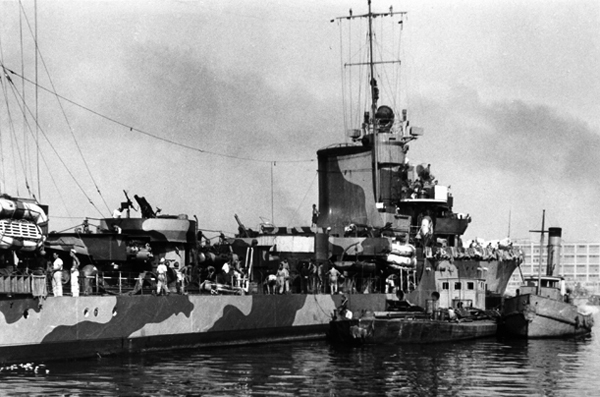
Grecale in 1942, rear view – Associazione Venus

Author’s illustration of the Alfieri, camouflaged in wartime, Oriani class.
Specifications
Displacement: 1675 t. standard -2254 t. Full Load
Dimensions 106.7 m long, 10.15 m wide, 3.42 m draft
Propulsion: 2 propellers, 2 Parsons turbines, 3 boilers triple exp., 48,000 hp.
Top speed: 38 knots
Armament: 4 guns of 102 (2 × 2), 8 mitt. of 13.2 AA, 6 TLT 533 mm (2 × 3), 2 ASM mortars
Crew: 206
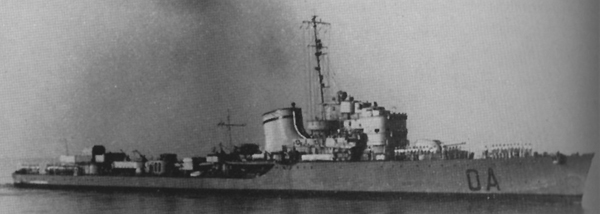
Oriani and her crew, 1945, then on the side of the allies, notice the dark hull paint
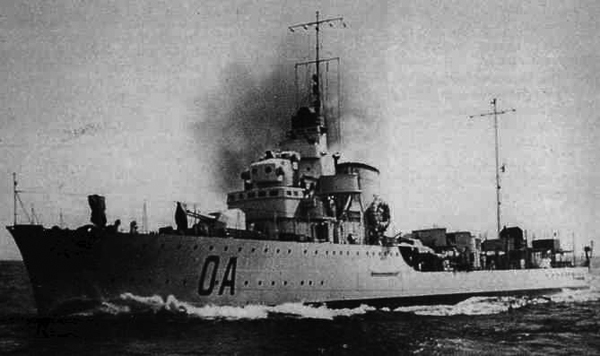
Soldati class destroyers (1938)
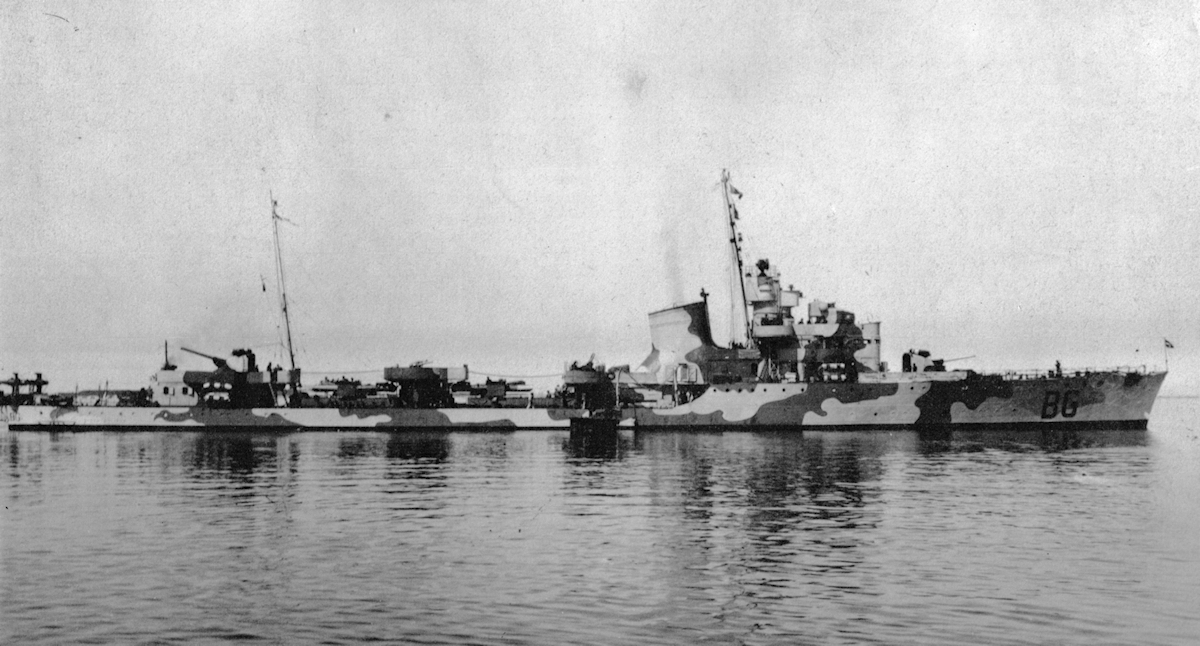
Bersagliere in 1942 – Ando 1976
The Admiralty decided that the Oriani/Maestrale formed the best base for a new series of improved destroyers. So it was the Soldati class, divided into two groups, one with 12 ships and one with 7. The first 12 were launched between 1937 and 1938, and the others in 1941-42. However, one of the second group was neither launched nor finished because of lack of equipment and men.
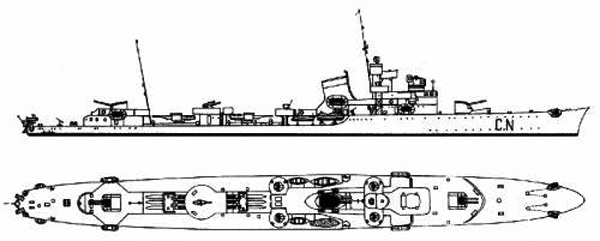
Blueprint of the Camicia Nera
They retained essentially all the features of the Oriani, including the hull, and had enlarged superstructures, and on some, an additional 120 mm gun in a central position, standard or flare gun (15 caliber mortar instead of 50). The AA armament was initially obsolete with six twin 13.2 mm machine guns, but increased to 8 x 20 mm guns in double mountings, then 10 to 12 in 1943. Others had their TTs rear bank replaced by two 37mm AA guns. 37 mm. Similarly, they were equipped with four ASW mortars.
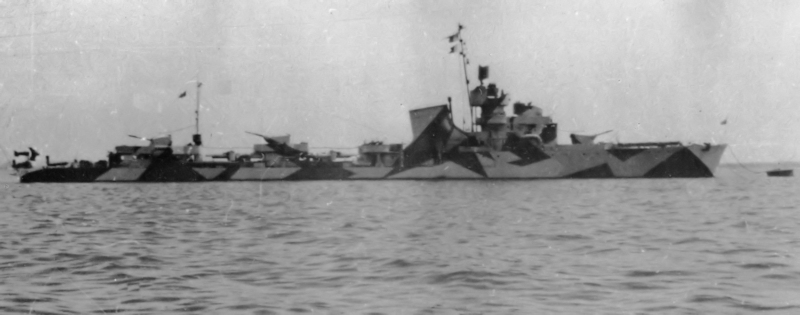
Legionario 1942 – Ando 1976
In operations, these destroyers proved their effectiveness, being able to withstand many hits without much damage, but very vulnerable to air attacks, because, as for the other Italian destroyers, they were given an initial too weak AA in comparison with of that of the Germans or allies. The Artigliere was sunk in October 1940, a total of 10 others being sunk in 1942-43. the survivors were for three of them transmitted to France in 1948 (Renamed Duchaffault, Jurien de la Gravière, Duperré), two to the USSR in 1949 (renamed Z12 and Z20), and two donated to the Italian Navy, remaining in service after modernization until 1958-60.

General appearance of the Soldati class. Most were camouflaged with typical angular pattern of black spots on blue waves and light grey background.
Specifications
Déplacement 1 690 t. standard -2 250 t. Pleine Charge
Dimensions 106,7 m long, 10,15 m large, 3,5 m de tirant d’eau
Machines 2 hélices, 2 turbines Belluzo/Parsons, 3 chaudières Yarrow, 48 000 cv.
Vitesse maximale 38 nœuds
Armement 4-5 canons de 120 (2×2, 1×1), 12 de 13.2 AA, 6 TLT 533 mm (2×3), 2 mortiers ASM
Équipage 206
Medaglie d’Oro class class destroyers (1941)
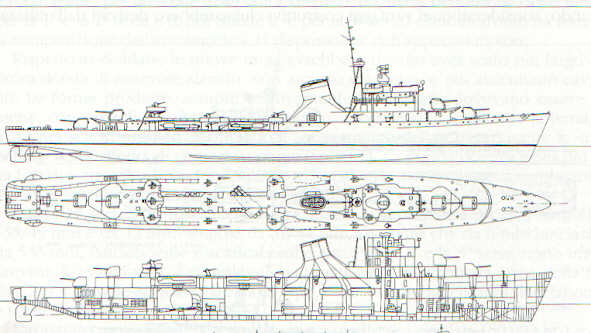
Comandante Margottini, the most advanced of the 1st serie.
In 1941, in the light of the first engagements, the Admiralty worked on a new type of destroyers intended to enter into service in 1943. It was the Comandanti Medaglie d’Oro class, which was characterized mainly by increased dimensions (120 meters long by 12.3 wide and 2900 tons at full load), a much better AA armament (13 x 37 mm shielded guns), and also main guns of 135 mm instead of 120 mm, in single turrets, and a reinforced hull. Nine of the first group were stopped in 1942-43, and none launched before the Germans seized the yards. The latter managed to restart their construction, and in 1944 launched Commandante Margottini, which remained uncompleted but was eventually loaded with explosives in the port of La Speziato be scuttled. These will partly inspire Italian destroyers after the war.
A word about Italian Torpedo Boats

Torpediniere Castore 1942 (Spica class) – USMM
Despite the fact the concept of torpedo boat was arguably obsolete in 1940, the Italians sticked to it and was probably the only Nation to rely on them so heavily. There are specific reasons for this, one being the particular territorial situation of Italy in the Mediterranean. In the same logic that make Mussolini speaks of the “aircraft carrier Italy” (before eventually order the conversion of liners, that’s a story for another day), the very long coastal areas offers many opportunity of efficient intervention for ships smaller than regular destroyers, with a reduced range.
The other main reasons was a clause in the Washington Naval Treaty, which stated that ships with a 600 tons and less could be built in unlimited numbers.
And when speaking of TBs, MAS boats are more often cited. Which are logically closer from the original torpedo boat idea. Therefore these Italian WW2 torpedo boats should be seen more as “light destroyers”, a bit like the escort destroyers that will be built en masse by the US Navy and Japan. Apart of the WW1-era destroyers reclassified as TBs, those we are talking about are 1930s to 1940s TBs, namely the 600 tons Spica class (1934) of 30 ships, the Pegaso class of 840 tons (1936, 1575 tons fully loaded, well beyond the Washington treaty limits) four ships, and wartime Ciclone class (1942, 16x 910 tons ships) and smaller Ariete class (1943, 16x 745 tons ships).
The Ciclone for example had a 4000 nautical miles range, and typically two 100 mm guns and four 450 mm TTs, but also eight 20mm AA guns and four deep-charge ASW throwers. This was not on par with any destroyers standards but these ships still could replace destroyers as escort vessels. And that was a force of about 67 ships, which is still numerically important. There will be a dedicated post about them soon.
Sources/Read More
Conway’s all the world’s fighting ships 1906-1921, 1922-1947
italiandestroyers.com
Alfredo Oriani
www.secondeguerre.net
On fr.naval-encyclopedia.com
On wikipedia.org

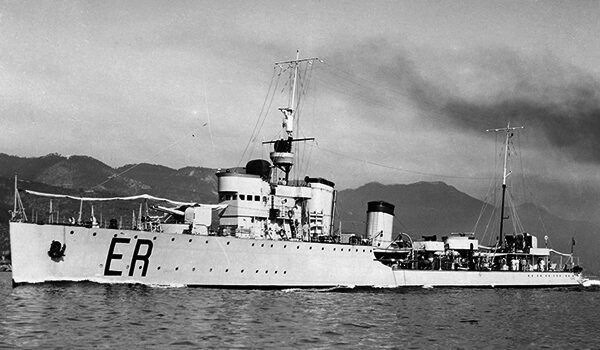
 Latest Facebook Entry -
Latest Facebook Entry -  X(Tweeter) Naval Encyclopedia's deck archive
X(Tweeter) Naval Encyclopedia's deck archive Instagram (@navalencyc)
Instagram (@navalencyc)





 French Navy
French Navy Royal Navy
Royal Navy Russian Navy
Russian Navy Armada Espanola
Armada Espanola Austrian Navy
Austrian Navy K.u.K. Kriegsmarine
K.u.K. Kriegsmarine Dansk Marine
Dansk Marine Nautiko Hellenon
Nautiko Hellenon Koninklije Marine 1870
Koninklije Marine 1870 Marinha do Brasil
Marinha do Brasil Osmanlı Donanması
Osmanlı Donanması Marina Do Peru
Marina Do Peru Marinha do Portugal
Marinha do Portugal Regia Marina 1870
Regia Marina 1870 Nihhon Kaigun 1870
Nihhon Kaigun 1870 Preußische Marine 1870
Preußische Marine 1870 Russkiy Flot 1870
Russkiy Flot 1870 Svenska marinen
Svenska marinen Søværnet
Søværnet Union Navy
Union Navy Confederate Navy
Confederate Navy Armada de Argentina
Armada de Argentina Imperial Chinese Navy
Imperial Chinese Navy Marinha do Portugal
Marinha do Portugal Mexico
Mexico Kaiserliche Marine
Kaiserliche Marine 1898 US Navy
1898 US Navy Sovietskiy Flot
Sovietskiy Flot Royal Canadian Navy
Royal Canadian Navy Royal Australian Navy
Royal Australian Navy RNZN Fleet
RNZN Fleet Chinese Navy 1937
Chinese Navy 1937 Kriegsmarine
Kriegsmarine Chilean Navy
Chilean Navy Danish Navy
Danish Navy Finnish Navy
Finnish Navy Hellenic Navy
Hellenic Navy Polish Navy
Polish Navy Romanian Navy
Romanian Navy Turkish Navy
Turkish Navy Royal Yugoslav Navy
Royal Yugoslav Navy Royal Thai Navy
Royal Thai Navy Minor Navies
Minor Navies Albania
Albania Austria
Austria Belgium
Belgium Columbia
Columbia Costa Rica
Costa Rica Cuba
Cuba Czechoslovakia
Czechoslovakia Dominican Republic
Dominican Republic Haiti
Haiti Hungary
Hungary Honduras
Honduras Estonia
Estonia Iceland
Iceland Eire
Eire Equador
Equador Iran
Iran Iraq
Iraq Latvia
Latvia Liberia
Liberia Lithuania
Lithuania Mandchukuo
Mandchukuo Morocco
Morocco Nicaragua
Nicaragua Persia
Persia San Salvador
San Salvador Sarawak
Sarawak Uruguay
Uruguay Venezuela
Venezuela Zanzibar
Zanzibar Warsaw Pact Navies
Warsaw Pact Navies Bulgaria
Bulgaria Hungary
Hungary

 Bundesmarine
Bundesmarine Dutch Navy
Dutch Navy Hellenic Navy
Hellenic Navy Marina Militare
Marina Militare Yugoslav Navy
Yugoslav Navy Chinese Navy
Chinese Navy Indian Navy
Indian Navy Indonesian Navy
Indonesian Navy JMSDF
JMSDF North Korean Navy
North Korean Navy Pakistani Navy
Pakistani Navy Philippines Navy
Philippines Navy ROKN
ROKN Rep. of Singapore Navy
Rep. of Singapore Navy Taiwanese Navy
Taiwanese Navy IDF Navy
IDF Navy Saudi Navy
Saudi Navy Royal New Zealand Navy
Royal New Zealand Navy Egyptian Navy
Egyptian Navy South African Navy
South African Navy






























 Ukrainian Navy
Ukrainian Navy dbodesign
dbodesign